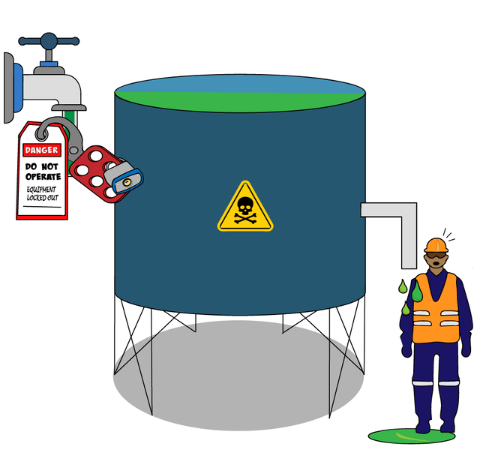De-energization and Lockout: Critical steps for safe maintenance
- Posted on
- By Birgit
- 0

De-energization and lockout are two essential steps in the Lockout Tagout (LOTO) process, a safety procedure used to isolate and control hazardous energy during maintenance or repair work on machinery and equipment. These procedures are designed to protect workers from the unexpected startup, movement, or energy release from machines and installations, which could result in injury or even fatal accidents.
The process
De-energization simply means removing or disconnecting energy from a device or system before performing maintenance, repairs, or other work. The goal is to ensure no hazardous energy is present that could be unexpectedly released, causing accidental startup or sudden energy discharge that might endanger the safety of the maintenance team.
The de-energization process includes various steps, such as switching off the equipment, unplugging, disconnecting, switching off circuit breakers, or shutting down energy sources like hydraulic and pneumatic systems. De-energization is a vital safety measure in industrial environments because it ensures a safe working environment during work on machinery or installations. This process involves verifying that all energy has been truly removed by testing the system or draining residual energy.
Once de-energization is complete, lockout is applied. Lockout involves placing a safety padlock or another lockout-tagout device on the equipment or energy source, such as a circuit breaker lockout or a valve lockout. This prevents the device or energy source from being unintentionally powered on while workers are engaged with it.
What is Hazardous Energy?
Hazardous energy refers to energy sources that, if left uncontrolled or unexpectedly released, can cause severe injury or even death. Below are some types of hazardous energy, along with examples of the risks they pose:
- Electrical energy: found in high- and low-voltage lines and equipment. Exposure can lead to electric shock, secondary injury from falls or startled reactions, and fire from arcing.
- Chemical energy: released during chemical reactions. Hazardous reactions, like combustion or explosion, can occur upon contact with certain substances, resulting in fire or serious injury.
- Thermal energy: present in extreme temperatures, such as explosions or flames. Exposure can lead to burns or, at low temperatures, frostbite.
- Radiation energy: from electromagnetic sources like lasers and X-rays. Unprotected exposure can cause burns, radiation sickness, and, in some cases, genetic damage.
- Kinetic energy is present in moving equipment or materials. Even after shutdown, parts may keep moving or unexpectedly activate, posing significant injury risks.
By identifying these energy sources and applying de-energization, companies can create a safer work environment and significantly reduce accident risks.
What is Potential Energy?
In addition to hazardous energy, there is potential energy, which refers to stored energy in an object or system. This energy can transform into other forms when the object moves or changes state. This energy is often found in raised, suspended, or coiled materials and is a crucial concept in physics and engineering. Potential energy can manifest in various forms depending on the specific circumstances and environment.
In industrial and technical applications, understanding different types of potential energy is essential, particularly in terms of safety. Here are three important types of potential energy, each with unique characteristics and risks that could lead to accidents if not properly managed:
- Hydraulic potential energy: Energy stored in a pressurized fluid. For example, pressurized fluid can be used to move heavy objects, machines, or equipment, such as a lift in a car garage. Releasing hydraulic energy can result in crushing or impact injuries from moving machinery or objects.
- Pneumatic potential energy: Energy stored in compressed air. Pressurized air can move heavy objects and power equipment. Uncontrolled release of pneumatic energy can also cause injury from moving machinery or objects.
- Gravitational potential energy: Energy related to the mass of an object and its distance from the ground. If an object is susceptible to falling or rolling due to gravity, like a ball on a hill, it has gravitational potential energy.
How Do I Identify Hazardous Energy and Assess Risks?
Before starting work, a risk assessment should be conducted to identify hazardous energy related to the tasks. The following should be included:
- Identify all tasks to be performed
- Identify all potential sources of hazardous energy
- Assess the risk level for each task and associated hazard
- Determine how each identified energy source should be de-energized
- Identify all de-energized energy control devices that must be locked out
De-energization and lockout are essential safety measures to isolate hazardous energy sources and prevent the unintended activation of machines or equipment. These procedures are necessary to protect workers from injury due to unexpected energy discharges during maintenance or repairs. Various types of hazardous energy, such as electrical, thermal, chemical, and potential energy, must be identified and controlled. A thorough risk assessment and clear lockout procedures are essential for safe work with hazardous machines and energy sources.
If you would like to find out more or have any questions, please do not hesitate to contact us.




















Comments
Be the first to comment...